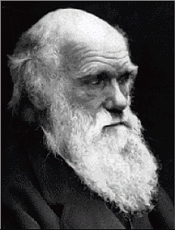 |
TOLFA Segment 17 | Biology |
 The "study of living things": what an enormous field of interest, for free-minded people to explore!
As for Art and Astronomy (for those considering these Segment 17 pages in alpha sequence) it would
take several lifetimes and still we'd not have found all that can be known. But once again:
it's a scene at which we humans can gaze in awe. We can wonder: what
exactly makes a newborn draw his first breath?
What exactly is "hunger?" How come we rely entirely upon a whole slew of internal organs long before
we even know we have them, let alone begin to understand what they do or how? What makes a
finger or toe nail grow so relatively fast? What exactly is "fear?" And how on Earth does it happen
that the sight, sound, smell and touch of a member of the opposite sex can set in motion a series
of actions that results in the propagation of the species? Why are dogs so affectionate and fun-loving?
The "study of living things": what an enormous field of interest, for free-minded people to explore!
As for Art and Astronomy (for those considering these Segment 17 pages in alpha sequence) it would
take several lifetimes and still we'd not have found all that can be known. But once again:
it's a scene at which we humans can gaze in awe. We can wonder: what
exactly makes a newborn draw his first breath?
What exactly is "hunger?" How come we rely entirely upon a whole slew of internal organs long before
we even know we have them, let alone begin to understand what they do or how? What makes a
finger or toe nail grow so relatively fast? What exactly is "fear?" And how on Earth does it happen
that the sight, sound, smell and touch of a member of the opposite sex can set in motion a series
of actions that results in the propagation of the species? Why are dogs so affectionate and fun-loving?
Perhaps the first thing to wonder at is the fact that anything lives rather than simply lying there like rock or dust, as it does on the Moon. One again our curiosity is peeked: how did life begin? Obvious, but perhaps there's a less obvious but even more awesome point at which to wonder: how come there developed a species - homo sapiens - capable of asking such a question? That is, when we think about it, more amazing yet; and we touched on it in Segment 1 of TOLFA.
 Here's another provocative question: how exactly are we to define "life" anyway? The answer may
seem simple, until we start putting it into words and until we notice what crystals do. Crystals are
rocks, often simple "inorganic" minerals - and yet they grow, sometimes very visibly. Are they then alive?
Why, or why not; how exactly do they differ from the simplest of living organisms? The left-hand photo comes
from a handy how-to-grow
site and others can be Googled, for example
this one that
spells out how to grow a sugar crystal, beautifully illustrated below by a photo taken with polarized light.
Here's another provocative question: how exactly are we to define "life" anyway? The answer may
seem simple, until we start putting it into words and until we notice what crystals do. Crystals are
rocks, often simple "inorganic" minerals - and yet they grow, sometimes very visibly. Are they then alive?
Why, or why not; how exactly do they differ from the simplest of living organisms? The left-hand photo comes
from a handy how-to-grow
site and others can be Googled, for example
this one that
spells out how to grow a sugar crystal, beautifully illustrated below by a photo taken with polarized light.
 The usual convention, though, is to think of "life" as consisting of entities built from highly complex organic
molecules which can self-replicate as well as grow. Unconventional though TOLFA generally is,
we'll go along with that for now
The usual convention, though, is to think of "life" as consisting of entities built from highly complex organic
molecules which can self-replicate as well as grow. Unconventional though TOLFA generally is,
we'll go along with that for now 
Progress in understanding both the origin of life and its breathtaking development and variety has once again hindered by religious mythology, allied to and often enforced by government. That progress has been phenomenal since the mid-1800s, with enormous benefit to all in terms (eg) of the proper theoretical basis it provides for medical care; but even that has been achieved in the teeth of opposition by the established mythologists. Life was created by God, so they insist, and don't you dare disagree or (as in the Scopes "Monkey Trial") we'll get our friends in government to hammer you with their fines. (Bizarre sidelight on that Trial; government people have since changed sides, so its textbooks and TV documentaries now endorse evolution. So much so, they carefully avoid mention of the ugly fact that the particular textbook Scopes had used - in a government school - openly promoted racism. Oops!)
Our understanding of the development or evolution of life is, so far, more comprehensive than that of how it began, which is still speculative - not surprisingly, since it took place about 3½ billlion years ago (though cells with a nucleus are half that age) so there's little or no observation possible, from which a theory could be deduced. Even so, the basic building-blocks of life (amino acids and a few other large molecules) have been synthesized in the laboratory from much simpler compounds just by leaving them in conditions that almost certainly prevailed while the Earth was cooling. This exciting field of research is far from complete, but it's getting closer.
 The development or evolution from simple life forms to more complex ones, and from one complex form
to another, is far better understood thanks in very large part to one patient naturalist from England,
Charles Darwin. He was a classic scientist; first observe, then reason and form a theory to explain the
observations, then test the theory, then start the cycle over. That's the scientific method; it depends
only on the basic premise (axiom!) that A is A; that is, that things are what they appear to be. And
yes, the premise that we can reliably observe them. Darwin spent his life observing nature in all its
forms, ever curious to know how living things were made up, how they compared, why they were colored
and shaped thus and so, etc. And his famous theory, that of "Evolution," brilliantly explains how one
species can evolve into another by small incremental steps over an amazingly brief span of time; the
soundness of the theory is attested by the fact that in the late 1800s there was no way he could have
guessed how those mutations could take place. He merely observed their result, and theorized
that there must be a way for it to happen.
The development or evolution from simple life forms to more complex ones, and from one complex form
to another, is far better understood thanks in very large part to one patient naturalist from England,
Charles Darwin. He was a classic scientist; first observe, then reason and form a theory to explain the
observations, then test the theory, then start the cycle over. That's the scientific method; it depends
only on the basic premise (axiom!) that A is A; that is, that things are what they appear to be. And
yes, the premise that we can reliably observe them. Darwin spent his life observing nature in all its
forms, ever curious to know how living things were made up, how they compared, why they were colored
and shaped thus and so, etc. And his famous theory, that of "Evolution," brilliantly explains how one
species can evolve into another by small incremental steps over an amazingly brief span of time; the
soundness of the theory is attested by the fact that in the late 1800s there was no way he could have
guessed how those mutations could take place. He merely observed their result, and theorized
that there must be a way for it to happen.
 He was vindicated during the next century, with its discovery of atomic structure and of radiation
(from the Sun and elsewhere)
and, in 1954 by Crick and Watson, of DNA: the large twisted molecule that carries building
instructions from one generation of a species to the next. Mutation occurs when one or more of the
molecules attached to the DNA helix is modified, very probably by a stray ray. The new mutant survives
if suited to its environment as well or better than its parent, otherwise never grows to reproduce.
He was vindicated during the next century, with its discovery of atomic structure and of radiation
(from the Sun and elsewhere)
and, in 1954 by Crick and Watson, of DNA: the large twisted molecule that carries building
instructions from one generation of a species to the next. Mutation occurs when one or more of the
molecules attached to the DNA helix is modified, very probably by a stray ray. The new mutant survives
if suited to its environment as well or better than its parent, otherwise never grows to reproduce.
That's the theory, and it's very well attested. Diehard creationists continue to oppose it, often alleging that the half billion years or so that have elapsed since the first marine invertebrates appeared would be far too short a time for the evolution of the hundreds of thousands of species of plant and animal which exist or have existed. They are wrong, and that is demonstrated beautifully in Richard Dawkins' pathbreaking book "The Blind Watchmaker" - strongly recommended. Evolution, he shows, can progress with astonishing speed and the marvel is not so much that there are so many different species, but rather that there are so few!
Dr Dawkins' more recent book on zoology, "The Ancestor's Tale," is also a terrific read, for it traces (backwards!) the evolutionary process from the present day to the earliest appearance of life. It's a brief history of life on Earth; totally fascinating.
The government-driven culture in which we live promotes reliance on its "experts" instead of encouraging independent, curiosity-driven enquiry and study. There can hardly be a more fascinating field of study than life itself, so as the governed era draws to its close, explore it!






